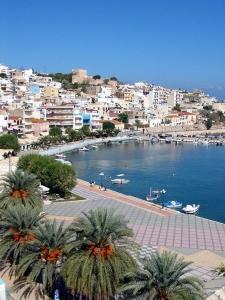|
Sitia Town

Sitia |
Welcome to Sitia!
Sitia (or Siteia) is amphitheatrically built around a hill in Sitia Bay, the easternmost one on Crete’s north coast. Next to it, there is a fantastic beach with white, fine sand stretching down to the crystal clear sea, where one can easily take a swim nine months of the year. The specific part of the island around Sitia has a milder landscape than most of the rest of Crete, with smaller mountains and fertile plains.
The city has a long history, and not astonishingly so as it is Crete that we talk about after all! It is built on top of the ruins of ancient Eteia, the port of the city of Praissos. When the Dorians invaded the island, not all of the indigenous inhabitants showed an interest to mix with them; Eteocretans had fled to the interior of Crete to avoid coming in contact with the Dorian usurpers of their land. Later, in 146 BC, the city of Praissos was destroyed by Ierapetra, and its inhabitants moved here; as a result, the city enjoyed a position of strength.
Eteia continued to flourish in the subsequent centuries, under Roman, Byzantine, and Venetian rulers. During the crusades, it was taken by the Genoese, who rebuilt the ruined pre-existing Byzantine castle. The city continued to prosper until 1508, when it was destroyed by a great earthquake. Thirty years later, the city was destroyed again, this time by a pirate attack.
The Venetian rulers were obviously unable to protect the city, and it was eventually abandoned by its inhabitants in 1651 AD. This was the time of the rise of the Ottoman power, and the Venetians were trying to regroup their forces. Obeying this need, the Venetians destroyed the castle of the city themselves, so as to deprive the eventual conquerors of a strategic stronghold.
These ruins are still there today for all to visit. The castle is partly destroyed, and one tower only still stands. The pre-existing monastery of Santa Maria, in the northern part of the castle and not demolished by the Venetians, was destroyed by the Turks. The place, since that time, has been used as a cemetery. In 1870, some forty years before Sitia was liberated and, together with the rest of Crete, united with Greece, the local Turkish Pasha had the town rebuilt, and his plans are predominant even today.
|
|
|
|



